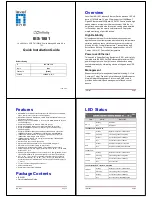
17-6
Catalyst 2975 Switch Software Configuration Guide
OL-19720-02
Chapter 17 Configuring MSTP
Understanding MSTP
Hop Count
The IST and MST instances do not use the message-age and maximum-age information in the
configuration BPDU to compute the spanning-tree topology. Instead, they use the path cost to the root
and a hop-count mechanism similar to the IP time-to-live (TTL) mechanism.
By using the
spanning-tree mst max-hops
global configuration command, you can configure the
maximum hops inside the region and apply it to the IST and all MST instances in that region. The hop
count achieves the same result as the message-age information (triggers a reconfiguration). The root
switch of the instance always sends a BPDU (or M-record) with a cost of 0 and the hop count set to the
maximum value. When a switch receives this BPDU, it decrements the received remaining hop count by
one and propagates this value as the remaining hop count in the BPDUs it generates. When the count
reaches zero, the switch discards the BPDU and ages the information held for the port.
The message-age and maximum-age information in the RSTP portion of the BPDU remain the same
throughout the region, and the same values are propagated by the region designated ports at the
boundary.
Boundary Ports
In the Cisco prestandard implementation, a boundary port connects an MST region to a single
spanning-tree region running RSTP, to a single spanning-tree region running PVST+ or rapid PVST+,
or to another MST region with a different MST configuration. A boundary port also connects to a LAN,
the designated switch of which is either a single spanning-tree switch or a switch with a different MST
configuration.
There is no definition of a boundary port in the IEEE 802.1s standard. The IEEE 802.1Q-2002 standard
identifies two kinds of messages that a port can receive: internal (coming from the same region) and
external. When a message is external, it is received only by the CIST. If the CIST role is root or alternate,
or if the external BPDU is a topology change, it could have an impact on the MST instances. When a
message is internal, the CIST part is received by the CIST, and each MST instance receives its respective
M-record. The Cisco prestandard implementation treats a port that receives an external message as a
boundary port. This means a port cannot receive a mix of internal and external messages.
An MST region includes both switches and LANs. A segment belongs to the region of its designated
port. Therefore, a port in a different region than the designated port for a segment is a boundary port.
This definition allows two ports internal to a region to share a segment with a port belonging to a
different region, creating the possibility of receiving both internal and external messages on a port.
The primary change from the Cisco prestandard implementation is that a designated port is not defined
as boundary, unless it is running in an STP-compatible mode.
Note
If there is a legacy STP switch on the segment, messages are always considered external.
The other change from the prestandard implementation is that the CIST regional root switch ID field is
now inserted where an RSTP or legacy IEEE 802.1Q switch has the sender switch ID. The whole region
performs like a single virtual switch by sending a consistent sender switch ID to neighboring switches.
In this example, switch C would receive a BPDU with the same consistent sender switch ID of root,
whether or not A or B is designated for the segment.
Содержание 2975 - Catalyst LAN Base Switch
Страница 36: ...Contents xxxvi Catalyst 2975 Switch Software Configuration Guide OL 19720 02 ...
Страница 40: ...xxxviii Catalyst 2975 Switch Software Configuration Guide OL 19720 02 Preface ...
Страница 62: ...1 22 Catalyst 2975 Switch Software Configuration Guide OL 19720 02 Chapter 1 Overview Where to Go Next ...
Страница 398: ...13 30 Catalyst 2975 Switch Software Configuration Guide OL 19720 02 Chapter 13 Configuring VLANs Configuring VMPS ...
Страница 424: ...15 18 Catalyst 2975 Switch Software Configuration Guide OL 19720 02 Chapter 15 Configuring VTP Monitoring VTP ...
Страница 628: ...26 8 Catalyst 2975 Switch Software Configuration Guide OL 19720 02 Chapter 26 Configuring UDLD Displaying UDLD Status ...
Страница 660: ...28 8 Catalyst 2975 Switch Software Configuration Guide OL 19720 02 Chapter 28 Configuring RMON Displaying RMON Status ...
Страница 888: ...38 32 Catalyst 2975 Switch Software Configuration Guide OL 19720 02 Chapter 38 Troubleshooting Troubleshooting Tables ...
















































